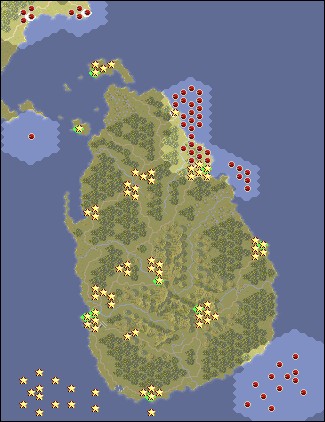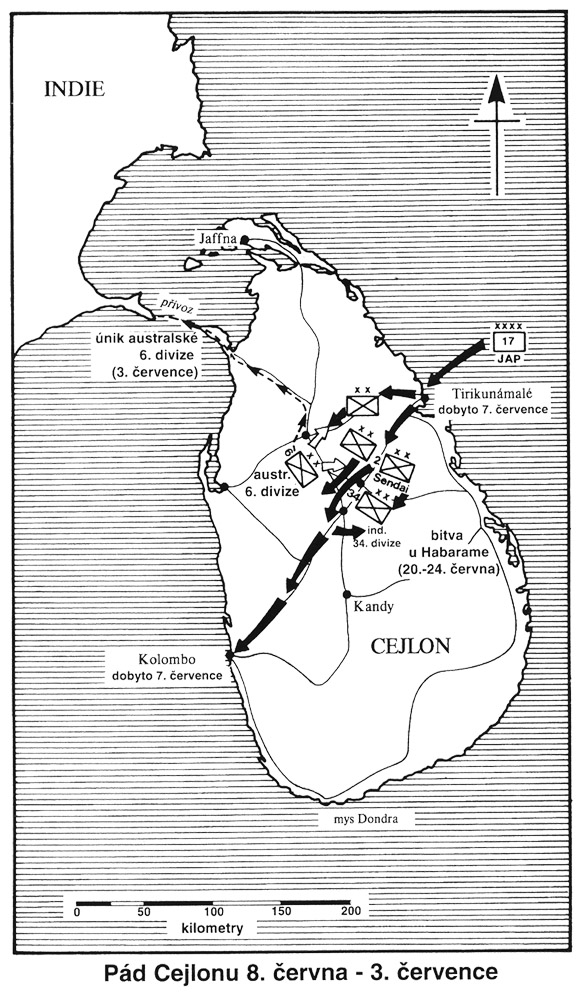 When you move the mouse pointer over the map, unit name, strength and coordinates are displayed as a label. When you press terrain button object name is displayed (city, river, sea, ...) |
Ceylon
PacPG: 20.11.1942 - 7.1.1943
Scenario Map:
|
|
|
Changes and corrections of map:
|
Scenario author: Scenario origin: Last revision date: |
stanny 18.11.2005 3.7.2011 |
First release: Revision released: |
4.4.2011 ( Relase 02 ) - |
| New scenario. Conquest of Ceylon island by Japanese-Vichy forces. |
Historic overview:
| Hypothetical scenario. The Japanese attack on Ceylon in collaboration with the Vichy French. The scenario is largely inspired by a chapter "Operation Orient" from the book The Hitler Options. The map is also from it. The Japanese did not actually attempt to invade Ceylon, but in April 1942 they launched a naval-aircraft raid into the Indian Ocean, attacking Ceylon bases in a hit-and-run fashion. Article on Czech Wikipedia Article on English Wikipedia
| |||||||||||||||||||||||||||
Game play matters:
| Campaign play: Defeat means the need to prevent the invasion of Americans on Roi-Namur in Marshall Islands. Minor victory means the same with possibility to choose defending another point of Marshall Islands - the island of Kwajalein. Major victory leads to Persia. Scenario rarities: In scenario, it is impossible to navigate ships between the Palk Strait and the Gulf of Mannar at Adam´s Bridge, which is a string of islets and coral shoals, which connects mainland India with Ceylon island and which is impassable for ships. Only in 2007 was digging for shipping. Unfortunately, due to the editing possibilities, although the movement of ships across hexech is blocked but while a ground unit can get on them. |
Scenario data:
|
Map size: 41 x 52 hexes 25 turns, 2 days per turn Version: PacPG 1, Starting side: Axis, Campaign: Japanese campaign, Order in campaign: 13. |
||||||||
|
||||||||
|
||||||||
|
||||||||
|
||||||||
|
Game time costingness of scenario: 44.31 % (product of units and turns numbers divided by difference between the most long and the most short scenario) |
||||||||
|
Number of Axis units: 67 units, from them are 23 core units and 44 auxiliary units 15 air units, 13 naval units and 39 ground units 0 of units are loaded to air transport and 23 to naval transport |
Transports Air/Naval: Axis - Allies 2/25 - 1/1 |
|||||||
|
Number of Allied units: 89 units 16 air units, 14 naval units and 59 ground units 0 of units are loaded to air transport and 0 to naval transport |
Initial prestige + every turn donation: Axis / Allies 300 + 0 / 180 + 90 |
|||||||
|
Max number of Axis units: 70 units, from them are 26 core units and 44 auxiliary units - on start of scenario is possible to purchase 3 unit (3 core + 0 auxiliary) |
||||||||
|
Max number of Allied units: 90 units - on start of scenario is possible to purchase 1 units |
||||||||
Transport units:
|
||||||||
|
| Axis units: Konoe Shidan (Imperial Guard) (Japan) Kyoka Hohei 1940 (Infantry HW 1940) (Japan) Hohei 1940 (Infantry 1940) (Japan) Senpaku Kohei (Engineers - SNLF) (Japan) Kohei (Bridge Engineers) (Japan) Shinhoto Chi-Ha (Japan) Type 98 Ke-Ni (Japan) Type 1 Chi-He (Japan) Type 95 Ha-Go (Japan) Type 92 6-Wheeled Armored Car (Japan) Type 1 47mm (Japan) RA 97 (Japan) Type 96 150mm (Japan) Type 38 120mm (Japan) Type 91 105mm (Japan) Type 96 AA Gun Prime Mover (Japan) Type 88 75mm (Japan) Ki-45 Nick (Toryu) (Japan) Ki-43 Oscar (Hayabusa) (Japan) A6M2 Zero (Reisen) (Japan) G4M Betty (Rikko) (Japan) D3A Val (Japan) B5N Kate (Japan) Ki-49 Helen (Donryu) (Japan) Submarine (Japan) Destroyer (Japan) Battleship class Yamato (Japan) Light Cruiser (Japan) Heavy Cruiser (Japan) Battleship class Kongo (Japan) Battleship class Fuso (Japan) Light Aircraft Carrier (Japan) Heavy Aircraft Carrier (Japan) Isuzu Type 94 6-Wheeled Truck (Japan) Transport (Japan) Legion Entrangere (Vichy France) Vichy Infantry (Vichy France) FR 47mm ATG (Vichy France) FR 105mm Gun (Vichy France) FR Truck (Vichy France) |
Allied units: Bridge Engineers (United Kingdom) Gurkhas (United Kingdom) HW Infantry 36 (United Kingdom) GB Infantry 39 (United Kingdom) Grant (United Kingdom) Matilda II (United Kingdom) Daimler Scout Car (United Kingdom) 6 Pdr ATG (United Kingdom) 2 Pdr ATG (United Kingdom) GB 5.5´´ Gun (United Kingdom) 25 Pdr Gun (United Kingdom) 3´´ AD (United Kingdom) 20mm AD (United Kingdom) Spitfire MkVB (United Kingdom) Spitfire MkVC (United Kingdom) Hurricane MkIIB (United Kingdom) Fairey Fulmar (United Kingdom) Hurricane MkIIA (United Kingdom) Swordfish MkI (United Kingdom) Blenheim MkI (United Kingdom) Submarine (United Kingdom) Destroyer (United Kingdom) Light Cruiser (United Kingdom) Heavy Cruiser (United Kingdom) Battleship (United Kingdom) Escort Aircraft Carrier (United Kingdom) Heavy Aircraft Carrier (United Kingdom) Brencarrier (United Kingdom) GB 3 Ton Lorry (United Kingdom) ANZAC 1940 (Australia & New Zealand) Matilda II (Australia & New Zealand) Vickers MkVI (Australia & New Zealand) 2 Pdr ATG (Australia & New Zealand) 25 Pdr Gun (Australia & New Zealand) 20mm AD (Australia & New Zealand) GB 3 Ton Lorry (Australia & New Zealand) Indian Infantry (India) Vickers MkI (India) 2 Pdr ATG (India) 25 Pdr Gun (India) 20mm AD (India) GB 3 Ton Lorry (India) |
The same time period scenarios:
| India (PacPG 1), Ceylon (PacPG 1) |
| Adam´s Bridge Airfield Anuradhapura Aruvi Aru Atirampattinam Badulla Batticaloa Bay of Bengal Colombo Daduru Oya Display all mapnames in list... |
Tactical map (large & detail):

|
|
|
|
Basic map |
|
|
Map with unloaded transports and order numbers of units |
Battlefield map:

|
|